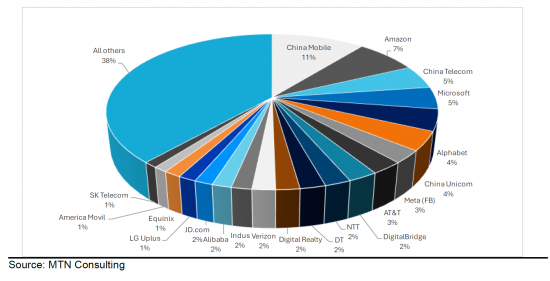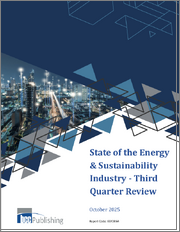
|
시장보고서
상품코드
1619728
통신사들의 지속가능성을 향한 첫걸음... 그러나 기후 변화는 빠르게 악화Operators Take Baby Steps Towards Sustainability as Climate Change Worsens Rapidly |
||||||
통신사업자에 의한 에너지 사용량 증가는 2023년에는 전년대비 4% 증가하여 감속했습니다. 그러나 통신 사업자는 기후 변화의 가장 큰 악화 요인이기도 합니다. 중국은 심각하게 지연됩니다.
본 보고서는 세계 네트워크 사업자의 에너지 소비와 환경 정책에 초점을 맞추고, 에너지 수요, 재생 가능 에너지의 이용, 배출량, 에너지 효율의 대처에 관한 데이터를 소개했습니다. 본 보고서는 2023년에 발행된 보고서에 새로운 데이터와 분석을 추가하여 업데이트한 것입니다.
비주얼
통신사업자 상위 20개사의 에너지 소비량 내역(2023년)

기후 변화에 대처하기 위한 세계의 다양한 대처는 크게 부족합니다. 유엔에 따르면 현재의 기후정책에서는 2100년까지 3.1℃ 이상의 지구온난화가 일어난다고 합니다. 이는 2015년 파리 협정에서 합의한 온난화 수준의 두 배에 해당합니다. 세계의 헤드라인을 대략 바라보면 이미 많은 기상 현상, 인구 이동, 심각한 경제적 피해가 발생하고 있습니다. 이대로, 지구는 인류에게 해마다 살기 어려워질 것입니다. 인류는 경제를 보다 지속가능한 궤도에 올리는 것보다 마지막 큰폭풍의 뒷처리에 시간과 돈을 소비하게 될 것이다.
이론상, 기술기업은 기후 변화와의 싸움을 주도할 기회가 있다고 생각되고 있습니다만, 실제로는 네트워크 사업자는 크게 실패하고 있습니다. 성장률은 지난 3년간의 약 9%에서 2023년에는 4% 성장이 둔화된 것은 플러스이지만, 수익의 성장이 더욱 둔화되었기 때문에 에너지 원단위가 약간 상승한 것과 최근 웹 스케일 분야에서 AI 데이터센터에 대한 투자가 폭발적으로 증가한 것이 아마도 2024년 추세선을 바꿀 전망입니다.
재생 가능 에너지는 어떻습니까? 재생 가능하고 탄소가없는 경우 에너지 소비는 본질적으로 나쁘지 않습니다. 사람의 데이터에 당황하게 됩니다. 2023년에는 통신 사업자가 소비합니다. 에너지 총량의 19.9%를 재생 가능 에너지가 차지했습니다. 또한 통신사업자의 온실가스 배출량은 2023년에는 약 1억 3,340만 톤(수익 100만 달러당 75톤) 이 숫자는 모두 2019년과 거의 동일합니다. 웹 스케일러에 관해서는 재생 가능 에너지의 이용률이 높지만, 생성형 AI의 흐름을 타고 있는 지금, 그들이 이 커밋멘 CNNO 중 일부는 에너지 효율성과 재생 가능 에너지에 많은 투자를 하고 있습니다. 그린의 대처를 과시하고 있는 곳도 있습니다. 또, 지속가능성의 문제를 거의 무시하고 있는 곳도 있습니다.
언급된 조직
|
|
목차
- 요약
- 통신 사업자의 에너지 소비량의 성장: 2023년에는 4%로 감속
- 3개 시장 부문의 상대적인 규모
- 에너지 : 네트워크 사업자에게 중요한 입력
- 사업자 유형별 에너지 소비량
- 사업자 유형별 에너지 강도
- 재생 가능 에너지의 사용량과 배출량
- 부록
Energy use growth by operators eased to 4% YoY in 2023 due to telcos, but they're also the worst climate offenders. Emissions are not falling; renewable energy adoption needs to accelerate. China lags badly.
This short report is focused on the energy consumption and environmental policies of the world's network operators. It presents data on energy demand, use of renewables, emissions, and energy efficiency efforts. This is an update of a report published in 2023 with new data and new analysis.
VISUALS
Breakdown of 2023 energy consumption by top 20 operators

The world's disparate efforts to address climate change are falling miserably short. Per the United Nations, current climate policies will result in global warming of more than 3.1C by the year 2100. That's twice the level of warming agreed upon in the 2015 Paris Agreement. A quick scan of the world's headlines will find many extreme weather events, population dislocations, and heavy economic damage already. If things continue, the planet will be less habitable for humans every year. Humanity will spend more time and money simply treading water - cleaning up after the last mega storm rather than putting economies on a more sustainable trajectory.
In theory, tech companies have an opportunity to lead in the fight against climate change. In practice, network operators are failing badly. Energy consumption continued to grow for the aggregate of the three segments in 2023. The growth rate dipped to 4% in 2023, from about 9% the previous three years. The slower growth is a plus, but: (1) revenues grew even more slowly, so energy intensity (consumption divided by revenue) increased slightly, and (2) a recent explosion of AI data center investment in the webscale sector will probably change the trendline in 2024.
How about renewables? There is nothing inherently bad about consuming energy, if it's renewable and carbon free. Economies need energy to run, just as your car needs fuel. However, data from the telco sector is disconcerting. In 2023, renewables accounted for 19.9% of total energy consumed by telcos. This figure has been rising by year, up from 10.3% in 2019. But 20% is low, and many easy changes have been made already. Further, greenhouse gas emissions (GHG) from telcos were about 133.4 million tons in 2023, or 75 tons per $1M in revenues; both figures are roughly the same as in 2019. If telcos are going to meet their carbon neutrality goals anytime soon, they need to attack these emissions aggressively, and that will cost. As for webscalers, they have a high rate of renewable use. Yet it's unclear if they will sustain this commitment now that they are on the GenAI bandwagon. For the third segment, carrier-neutral, it's a mixed bag. Some CNNOs invest heavily in energy efficiency and renewables, and some brag about their green practices. Others largely ignore questions of sustainability. The CNNO sector has absorbed assets from other segments over the years, so their infrastructure can have a patchwork quality, with different standards and designs in different regions. Also, sometimes CNNOs buy assets that are known to be energy hogs using dirty energy. Moreover, many CNNOs are owned by private equity or similar asset management firms, and don't publish financial data regularly, much less energy data. They face little to no public pressure to "go green." With right wing conservatives taking power in the US, there will be even less pressure on such companies.
Organizations mentioned:
|
|
Table of Contents
- Summary
- Operator energy consumption growth slows to 4% in 2023
- Relative size of three market segments
- Energy a key input for network operators
- Energy consumption by operator type
- Energy intensity by operator type
- Renewable energy use and emissions
- Appendix



















